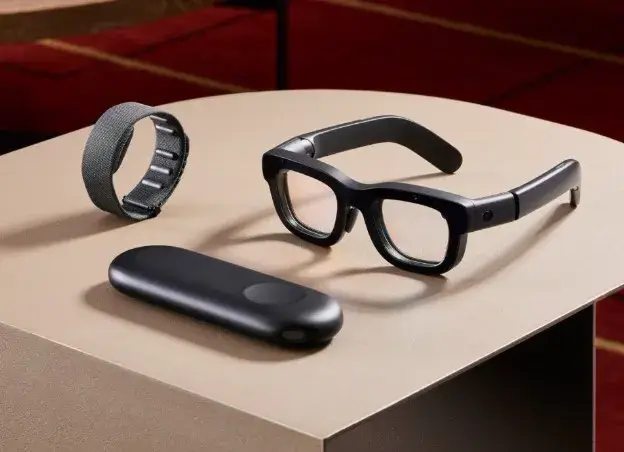Welcome to the future of augmented reality! Meta recently showed the first look of Orion AR Glasses. If blending the digital and physical worlds excites you, you’re in the right place. So, what exactly is Orion AR glass? How much will Orion glasses cost? What, indeed, will Orion glasses do?
Let’s dive into this blog as we explore the first genuine augmented reality glasses – Orion AR Glasses. We will explore Orion’s promising features and groundbreaking potential. Whether you’re a casual user, a tech enthusiast, or someone who loves the thrill of new gadgets, there’s something here for everyone. Let’s embark on this exciting journey together!
You May Also Like: ChatGPT Advanced Voice Mode: OpenAI Recently Developed Advanced Voice Mode
What are Orion AR glasses?
Orion AR glasses are an advanced augmented reality device designed to seamlessly overlay digital information onto the physical world. Unlike traditional VR headsets, which immerse users in a completely virtual environment, AR glasses enhance the real world by adding digital elements. This capability opens up exciting new possibilities in various fields, from gaming and education to healthcare and navigation.
Orion is Meta’s first pair of AR glasses. Orion was supposed to be a product you could buy, but it’s not. Instead, it’s a peek at what Meta has come for the hardware it’s releasing over the next few years. It’s a marker of where today’s smart glasses are eventually headed.
Orion AR Glasses can be used to browse the web, play games, and make video calls with people through Messenger.
Orion has three parts: the glasses themselves, a neural wristband for controlling them with finger movements, and a wireless compute puck that offloads app logic from the glasses to help improve battery life and reduce heat.

You navigate to the interface through eye and hand tracking, voice, and, most importantly, the neural wristband. In the simplest terms, your eyes or hands act as the mouse, and you click by pinching your fingers together.
You May Also Like: What is Sustainable Technology?
The Wristband concept is genuinely one of the most magical concepts to experience with a piece of new technology. It’s about the size of a Fitbit and uses electromyography to interpret neural signals and translate them into the input for the glasses. Electromyography is a technique for evaluating and recording the electrical activity of skeletal muscles.
The main gestures it recognizes are pinching your index finger with your thumb to select, pinching your middle finger and thumb to invoke the main menu, and swiping up or down with your thumb against your closed palm to scroll. There’s haptic feedback on the band to let you know when it recognizes a gesture, a helpful signal that makes you quickly comfortable using it.
The first thing you notice when you put Orion on is its 70-degree field of view, which is much broader than any AR glasses. A narrow field of view means that AR graphics don’t fill much of what you’re seeing, but with Orion, you have to get up pretty close to something before its edges start to disappear. This makes a massive difference in the overall experience.
ULED projectors inside the frame of Orion beam graphics in front of your vision via waveguides in the lenses are made of silicon carbide, not glass. Seven cameras and sensors in the frames sense the world around you to anchor virtual objects in space. You can leave a window open, turn your head and walk away, come back, and it’s still there.
The quality of the graphics isn’t at the level that you would want to watch a movie in glasses, but you have no problem reading text on a webpage several feet away. The demo shown consisted of experiences designed to simulate how one may use AR glasses throughout the day in the future.
Meta knows how people will use glasses like these, but the software is early. The demo was on rails and guided by Meta employees in the room to some of the tech experts to get the review and recommendations.
The coolest part of the demo was using Meta AI to identify ingredients for a smoothie on a table and then having the glasses show a recipe to make them with instructions. It was a peek at how generative AI can intersect with a form factor like this in powerful ways.
Mark Zuckerberg has been talking about AR glasses, and he calls it the Holy Grail device that will eventually replace smartphones. Orion is the first pair of AR glasses that can make you feel like the future isn’t so far away that it can feel like a pipe dream.
But a moment in the demo showed just how much work Meta still has to do to get this right. Orion was going to be a product Meta sold to the world until a couple of years ago when it realized it couldn’t manufacture them in a way that would even make sense at an ultra-high-end price point.
So, instead, about a thousand of them have been made for internal prototyping and demos. Meta is showing Orion to the world, but you can’t buy a pair now. Is just a prototype. After all these years and the billions of dollars poured into making them, the company wants something to show off, even if AR glasses aren’t ready for primetime.

Key Features of Orion AR Glasses
AI Capabilities: Meta unveils Orion AR glasses prototype with new AI capabilities. These glasses have advanced artificial intelligence, enabling intuitive, context-aware interactions. For example, Orion can provide real-time data about objects in your surroundings and recommend the best routes during commutes, or it can provide content by customizing recommendations based on user likings.
Eye Tracking: Orion’s eye-tracking technology allows users to select digital items by looking at them. The hands-free control mechanism assists to build up benefit and accessibility, especially for the individuals who have limited ability to move or be moved freely and easily.
Neural Wristband: Another standout feature is Orion’s neural wristband. It interprets electrical signals from your brain to control the glasses. The Orion technology makes sure that the reciprocal action are immediate and efficient for the individual.
Holographic Projection: Orion’s ability to project holograms is perhaps its most awe-inspiring feature. Imagine seeing a lifelike, three-dimensional virtual assistant sitting on your desk or receiving step-by-step cooking instructions superimposed directly onto your kitchen counter.
You May Also Like: Is Technology Going To Save the World or Kill It?
Conclusion: Embrace the Future with Orion AR Glasses
Orion AR glasses represent a significant leap forward in interacting with the digital world. With their advanced features, user-friendly design, and competitive pricing, they are poised to make a substantial impact. Whether navigating a busy city, engaging in cutting-edge gaming, or enhancing your professional productivity, Orion AR glasses offer a versatile solution.
FAQs
How much will Orion glasses cost?
One of the most commonly asked questions is about the pricing of Orion AR glasses. While specific prices can vary depending on the model and additional features, the expected cost of Orion AR glasses is estimated at around $500-$800. This price point positions them as a competitive option within the AR market, offering exceptional value for the range of capabilities included.
What do Orion glasses do?
Orion AR glasses are versatile, serving a multitude of functions:
1. Enhanced Navigation: Providing real-time directions and landmarks overlay, making wayfinding a breeze.
2. Interactive Gaming: Offering immersive gaming experiences by blending virtual elements with the real world.
3. Educational Tools: Enhancing learning by providing interactive and engaging educational content.
4. Productivity Boost: Enabling professionals to access information, documents, and tools hands-free.
5. Healthcare Applications: Assisting in medical procedures by overlaying essential data and instructions directly in the field of view.
What is unique about Orion?
So, what sets Orion apart from other AR glasses on the market?
1. Cutting-Edge Technology: Orion integrates the latest AR technology, ensuring a high-performance experience.
2. User-Centered Design: Prioritizing user comfort and accessibility, Orion glasses are designed with the user in mind.
3. Affordability: Despite the advanced features, Orion AR glasses remain affordable for a wide range of users.
4. Versatility: Suitable for various applications, from casual use to professional environments, enhancing versatility.
What are the benefits of AR smart glasses?
AR smart glasses like Orion offer numerous benefits:
1. Increased Efficiency: They allow users to access information and perform tasks more efficiently.
2. Hands-Free Operation: Perfect for multitasking and situations where hands-free operation is essential.
3. Enhanced Learning: Provides an interactive and engaging way to learn and train.
4. Better Navigation and Safety: Superior navigation aids and enhanced situational awareness improve safety.
5. Improved Communication: Collaboration becomes more effective with real-time data sharing and visualization.